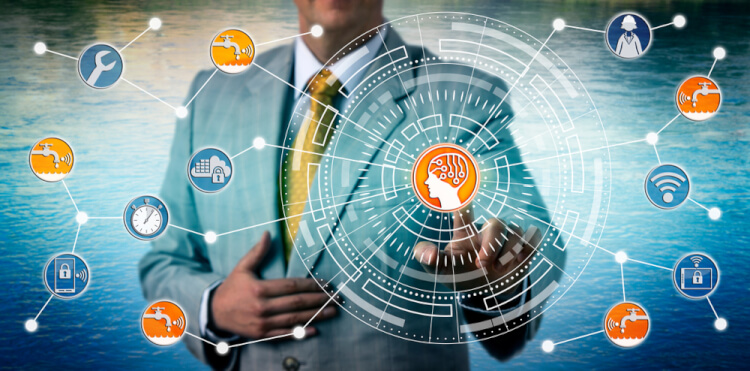Along with the spread of IoT , the provision of IoT platforms has also progressed in recent years . Therefore, in this article, we will explain the overview, characteristics, types, and points to choose from of IoT platforms. Especially if you are an IT person in a major company, we hope that you will deepen your understanding of the IoT platform, which is expected to be in high demand in future business, and use it as a reference when introducing it.

INDEX
- What is an IoT platform?
- Characteristics and role of IoT platform
- About types of IoT platforms
- Points for choosing an IoT platform
- summary
What is an IoT platform?
“IoT”, which stands for “Internet of Things”, refers to connecting various electrical appliances and electronic devices, such as home appliances in individual homes and line equipment in factories, through a network and linking their functions. An “IoT platform” is the infrastructure that supports the systems required for the IoT service.
Depending on the IT vendor, the range of IoT platforms provided varies. Some networks simply collect information from things, while others perform analysis after data collection. The target industries and industries are wide, and it has been introduced to automobiles, medical care, and agriculture as a recent trend.
They vary in size, with some systems collecting data from machines in their own factories and others collecting data from locations around the world. When adopting an IoT platform, it is important to choose a system that matches your business.
Characteristics and role of IoT platform
Then, what kind of business will be possible by introducing the IoT platform? We will explain the functional characteristics and roles of the IoT platform.
Connecting IoT devices
First, connect the devices and sensors and integrate the hardware necessary to enable the Internet of Things. PCs and business smartphones used in the company are also devices. Familiar examples of sensors include motion sensors used in automatic doors and sensors that respond to temperature and humidity.
Independent devices and sensors cannot function as a coordinated system. Connecting devices and sensors to the internet through drivers and software development tools is paramount in the role of IoT platforms.
Data collection
An IoT platform collects data from information devices connected to the Internet in order to provide desired information. However, even when service providers and users are connected via the Internet, there is often a long distance between information equipment for data collection and storage and devices used by users.
For example, remote elderly monitoring services and home care service workers receive information from a variety of remote locations. IoT platforms are being developed that are equipped with compact high-speed communication terminals and network environments so that data can be received without leaking even in such cases.
Data analysis/analysis
Depending on the IoT platform, it is not uncommon to connect with thousands or tens of thousands of devices simultaneously. The huge amount of big data collected from many devices can be analyzed in detail, and analysis can be performed to organize the roles and connections of data.
When used in agriculture, it is possible to determine when and how much water should be sprinkled by collecting and analyzing weather and temperature data for the day. Data analysis is also used in automatic reading devices, etc., and is useful for exit polls in elections and for monitoring vehicle license plates.
remote control
The IoT platform can control connected devices by remote control. This remote control function makes it possible to operate, stop, restart, and configure various settings without visiting the site.
A familiar example of this is smart home appliances that can be operated using a smartphone as a remote control. You can use your smartphone to operate air conditioners and robot vacuum cleaners, watch programs you have reserved for recording, and check the ingredients in your refrigerator with a camera.
Device management
Device management is a big role of IoT platform. It is necessary to constantly visualize the operating status of the device, display it in real time or in graphs, and monitor and manage the progress to see if there are any abnormalities. Some IoT platforms monitor the work status of the system and display the contents if an error is detected, and applications to systems that detect human error are also being considered.
Furthermore, the IoT platform enables integrated management of connected devices such as temperature/humidity centers, cameras, PCs, and smartphones. Registration, management, operation maintenance, inspection, and monitoring of devices and sensors can be performed centrally on the cloud. In addition, if the device supports it, multiple software can be updated wirelessly, improving operational efficiency.
About types of IoT platforms
An IoT platform with various functions and roles is the foundation that determines the quality of IoT services. The industrial IoT platforms currently in widespread use in the market can be broadly divided into “horizontal type” that is not bound by industry and ” vertical type” that specializes in specific industries such as manufacturing and energy.
The “horizontal type” aims to be a platform that can be used in all industries. On the other hand, the “vertical type” is further classified into three types: a type that builds all IoT services for a specific industry, a type that provides limited functions, and a type that covers other than development, introduction, and operation support. Here we will explain each type.
Horizontal/industry full coverage type
The backbone of the IoT platform is the set of cloud service infrastructure and basic applications such as data visualization, collection, and analysis. The “horizontal/industry full coverage type” IoT platform is a product that major system development companies pursue versatility. It offers its core functional range to any industry.
Other than the core part, in most cases, corporate users themselves customize it according to their industry. For example, an IoT platform that performs image analysis of surveillance cameras installed at railway stations, convenience stores, event venues, etc. is a typical example.
Vertical/functional full coverage type
The “vertical/functional full coverage type” covers all the functions required by specific industries, rather than supporting all industries. We cover all elements necessary for IoT service construction, from development to introduction, operation support, application applications, core cloud service infrastructure and basic applications, networks and sensors, according to your business.
It has a strong meaning of being a platform for “running IoT services from scratch” as a business, and can be built to order. However, on the other hand, it becomes necessary to replace the entire platform at the time of business conversion.
We can provide it mainly from major domestic system development companies such as “Hitachi”. On the other hand, there are also joint ventures such as LANDLOG, which has developed an open platform with the aim of digitizing the construction industry and improving productivity.
Vertical/app-provided type
The “vertical/app-providing type” provides functions that exclude development, introduction, and operation support from the “vertical/functional full-coverage type.” It is an IoT platform for businesses that does not require system development for their own business, and provides the entire operating environment for IoT services. The main form of introduction is the case of internal use of the IoT services required by the company’s industry.
In many cases, “vertical and functional full coverage” platforms are provided by major foreign manufacturers such as “Siemens”. It is often the case that companies that provide software and peripherals develop them.
Vertical/basic function provision type
The “vertical/basic function provision type” is the simplest IoT platform among the four types, providing services with narrowed down purposes and functions to be used. Available services are limited as some IT vendors provide them and specialize in limited functions for specific industries. It is ideal for introducing specific IoT service functions such as remote monitoring and preventive maintenance, and can be introduced at a lower cost than other IoT platforms.
Points for choosing an IoT platform
When considering an IoT platform, organize the project requirements by sorting out such things as whether the platform is necessary for your business, whether to build from scratch or to use an off-the-shelf product, and what functions are necessary. must be defined. Then, consider the above four types. The following three points are also important when choosing an IoT platform.
Connectivity
A factor that underpins the performance of IoT platforms is connectivity that is sufficient for data transfer and network communication. Since a large amount of data collected from the device is sent to the data center, communication speed and stability are essential.
There are various communication technologies and standards, and the optimal communication method changes depending on conditions such as the type of data to be transmitted, such as images and video, and the ease of connection. It is desirable to be able to support a wide range of communication standards such as wired/wireless LAN, wireless communication such as Bluetooth, and mobile data communication.
Scalability
An IoT platform connects many devices, incorporates a wide variety of sensors, and may require an operating environment of tens of thousands. Therefore, high scalability is required so that processing capacity does not drop even if many devices and sensors are connected simultaneously. When deploying IoT services in multiple industries, a horizontal platform with excellent scalability is suitable instead of a vertical one.
Security
IoT platforms become more vulnerable as they connect more devices and sensors. It is no exaggeration to say that there are always risks such as unauthorized access by third parties, information leaks, and deliberate device manipulation. In fact, there are cases where IoT devices such as smart speakers have been exploited in cyberattacks.
In order to prepare for these risks, it is important to adopt communication and authentication technologies such as PKI (Public Key Infrastructure), which simultaneously authenticates users and encrypts communications. Of course, remote management and software updates need to be done from time to time. When choosing an IoT platform, focus not only on functionality but also on security measures.
summary
IoT services, which promote the Internet of things, are accelerating around the world, and the IoT platform market is also expanding. Various products are available, including general-purpose types that can be used in all industries and types that are specialized for some functions in specific industries. Please refer to the contents introduced this time and choose the most suitable IoT platform for your company.


